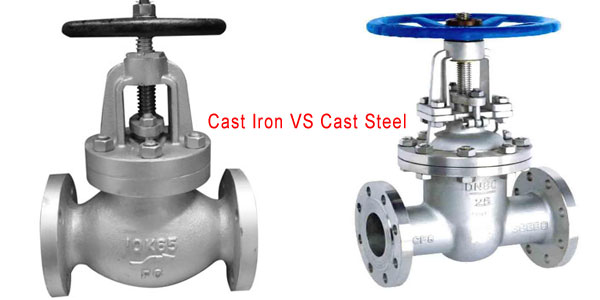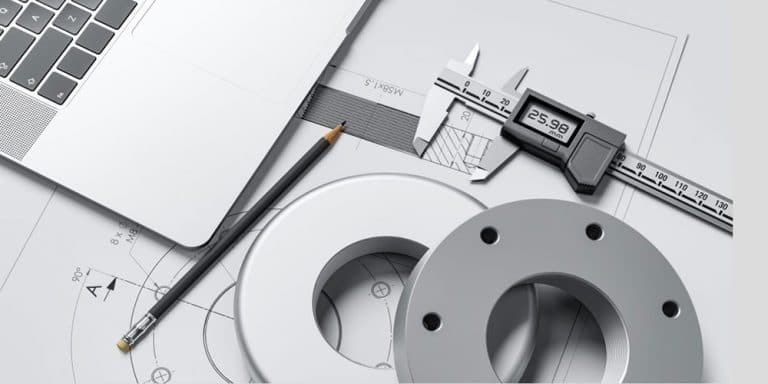Casting is one of the most popular ways to make lasting and quality components. Casting has a high level of detail. It does not need additional fabrication or assembly. Many different materials can be cast. Cast Iron vs Cast Steel is the two most popular due to their excellent mechanical properties for a wide range of applications.
JC Casting is a Casting manufacturer in China. Cast Iron and Cast steel is our main raw materials.
CAST IRON refers to gray iron, ductile iron, and malleable iron. It is an iron casting with a carbon content higher than 2%.
CAST STEEL refers to normal carbon steel and alloy steel. It is the steel casting with carbon content lower than 2%.
Below is the difference between Cast Iron vs Cast Steel.

Physical properties differences
There is no much difference between the chemical content and raw materials for cast iron and cast steel. But in their physical properties, there are many differences.
Cast iron advantage and disadvantage
Cast iron can be divided into gray iron and ductile iron.
The grey cast iron has good casting properties, vibration damping, wear resistance. Machinability, and low notch sensitivity. But, its tensile strength and elongation are very low. So grey cast iron is suitable for producing some metal parts with low mechanical requirements.
Such as protective cover, cover, oil pan, frame, floor, hammer, frame, knife, bed. bearing seat, cover, pump, valve, pipe, flywheel, motor blocks, etc.
Grey cast iron also has some high grades. So the grey iron castings with high grades can withstand the greater load and a certain degree of tightness and corrosion resistance.
Such as medium pressure valve, cylinder, gear. Flywheels, cylinder block, cylinder liner, piston, gearbox, brake wheel, coupling Plate, etc.
The ductile iron and malleable iron have higher strength, better ductility, heat resistance. And toughness than grey iron. So it has a wider application, in some applications, ductile iron can replace carbon steel. But, its production technology is high, the production process is more complex.
So ductile iron castings have more casting defects, and their production cost is higher than grey cast iron. Considering its advantages, there are many fields that ductile iron can be chosen.
Such as Pressure pipes and fittings, Automotive applications, Agriculture, road. And construction applications, General engineering applications.
Cast steel advantage and disadvantage
The design flexibility is the most advantage of cast steel. The designer of the casting has the greatest freedom of design choices. Especially for the complex shape and hollow cross-section parts.
Cast steel has the metallurgy manufacturing flexibility and strongest variability. You can choose a different chemical composition and control. Adapted to the various requirements of different projects. By different heat treatment choices in the larger context of the mechanical properties and performance. And good weldability and workability.
Steel castings can be used for a variety of working conditions. Its mechanical properties are superior to any other casting alloys. And a variety of high-alloy steel for special purposes. To withstand high tensile stress or dynamic load of components. It is important to pressure vessel castings in low or high temperatures by the large and important part-load key parts. They should give priority to steel castings.
The other difference Cast Iron vs Cast Steel
- 1-The main Different : Carbon Content (It was introduced above)
- 2-Materials Characteristic Difference
| Quality | Cast iron | Cast steel |
|---|---|---|
| Castability | ✔ | |
| Ease of machining | ✔ | |
| Vibration damping | ✔ | |
| Compressive strength | ✔ | |
| Impact resistance | ✔ | |
| Corrosion resistance | ✔ | ✔ (stainless alloys) |
| Wear resistance | ✔ (depending on application) | ✔ (depending on application) |
| Cost | ✔ |
- 3-Melting Point and Capability
Melting point: iron melts at about 2300˚F and steel melts at 2600˚F, and both are poured into molds at even hotter temperatures.But different in pour ability and shrinkage rates.Cast iron is relatively easy to cast, as it pours easily and doesn’t shrink as much as steel. This flow ability makes cast iron an ideal metal for architectural or ornate ironwork structures. Such as fencing and street furniture.
- 4- Machinability
Cast iron is typically much easier to machine than steel. The graphite structure in cast iron breaks away more easily, and in a more uniform manner. Steel isn’t as easy to cut with the same consistency, and it causes more tool wear, resulting in higher production costs. Hardened steels, or those with higher carbon content, also increase tool wear.
- 5-Impact Resistance
Steel has one significant advantage: impact resistance. Steel is excellent at withstanding sudden impacts without bending, deforming, or breaking. This is due to its toughness: its ability to withstand high stress and strain forces. Strength without ductility results in a brittle material that is highly susceptible to fracture. cast iron is the poster child for strength without ductility. Because of its brittleness, cast iron has a limited range of applications.
- 6-Wear Resistance
Cast iron typically has better resistance to mechanical wear than steel, especially in friction-wearing situations. The higher graphite content in cast iron creates a graphitic dry lubricant that allows solid surfaces to slide against each other without deteriorating surface quality. Steel wears more readily than iron. but may still be resistant to certain types of abrasion. Some alloy additions can also improve the abrasion qualities of Cast steel.
- 7-Cast iron and steel Application in an engine
Vibration damping properties make cast iron ideal for engine blocks. The graphite structures in cast iron, especially the flaked formations in gray cast iron, are especially good for absorbing vibration. This makes cast iron ideal for engine blocks, cylinder housings, and machine beds, and other applications where sturdiness and precision are important.
- 8-Compressive Stength
Compressive strength is the ability of a material to withstand forces that would reduce the object’s size. This is opposite to forces directed at pulling a material apart. Typically, cast iron has better compressive strength than steel.
- 9-Cost Different
Cast iron is often cheaper than cast steel. Cast Steel is also available in many prefabricated forms. Such as sheets, rods, bars, tubes, and beams. This can often be machined or assembled to suit a particular application. Depending on the product, and quantity required, fabricating existing steel products may be a cost-effective option.
How to choose Cast Iron or Cast Steel?
For cast iron vs cast steel, they have their own advantages and disadvantages. We can choose it as per your application and its physical properties.
Choosing Cast Iron:
1.If you do not have a high need to their mechanical properties. You can choose gray cast iron. Because its price will be the lowest than ductile iron and cast steel.
2.Select cast iron if heat retention is required as cast iron has higher thermal capacities
3..If the more compressive strength is required, go for cast iron
4…If you need an economic item then choose cast iron as grey iron is cheaper to produce.
5.. If you have a very high demand quantity, such as tens of thousands of pieces each year. You may need to consider cast iron made by automatic molding or shell molding process.
6.The use of Cast iron is normally limited to low temperature and pressure applications.
Choosing Cast Steel:
1.If you prefer the perfect surface quality and dimensional control. You could consider the steel castings made by the silica sol investment casting process, although its price will be very high.
2.If ductile behavior along with good strength is the need then choose Cast Steel.
3.If the end product is to be used in impact loading conditions use Cast Steel as it has higher toughness properties.
4.If you need very good thermal and electrical conductivity, select cast steel. Choose Cast Steel of flexibility in design.
5.Use Cast Steel for high temperature and pressure applications.
By the above explanation, maybe we can clear the difference between Cast Iron or Cast Steel? As a Cast Iron, casting carbon steel, cast steel foundry, we would like to get your communications or inquiries. If you have any requests, welcome to leave a message. Let us service you.

